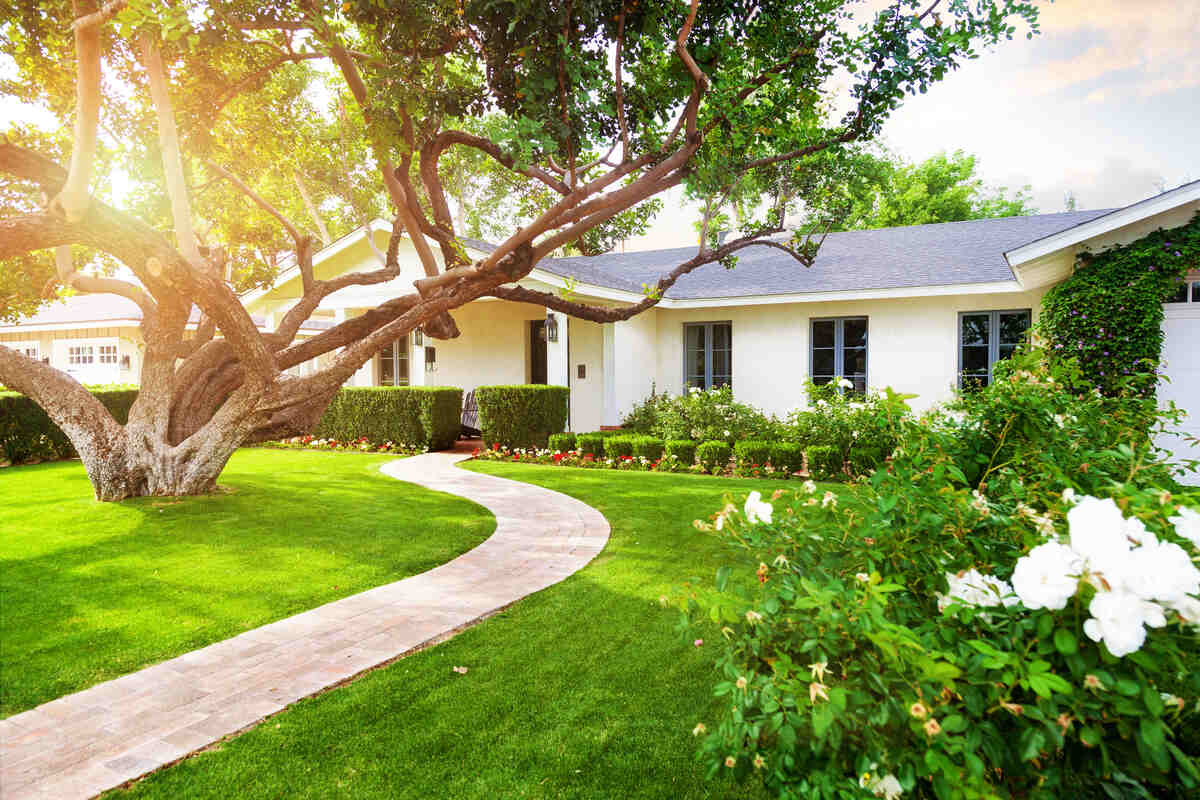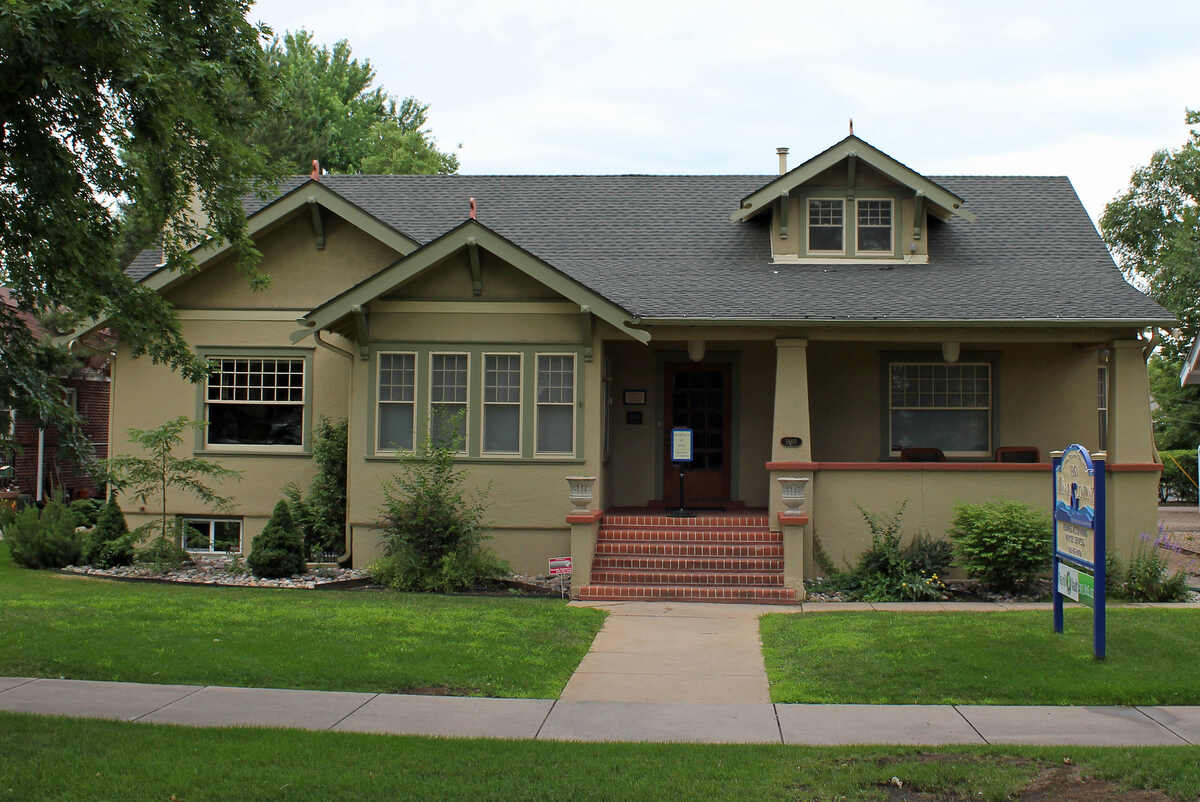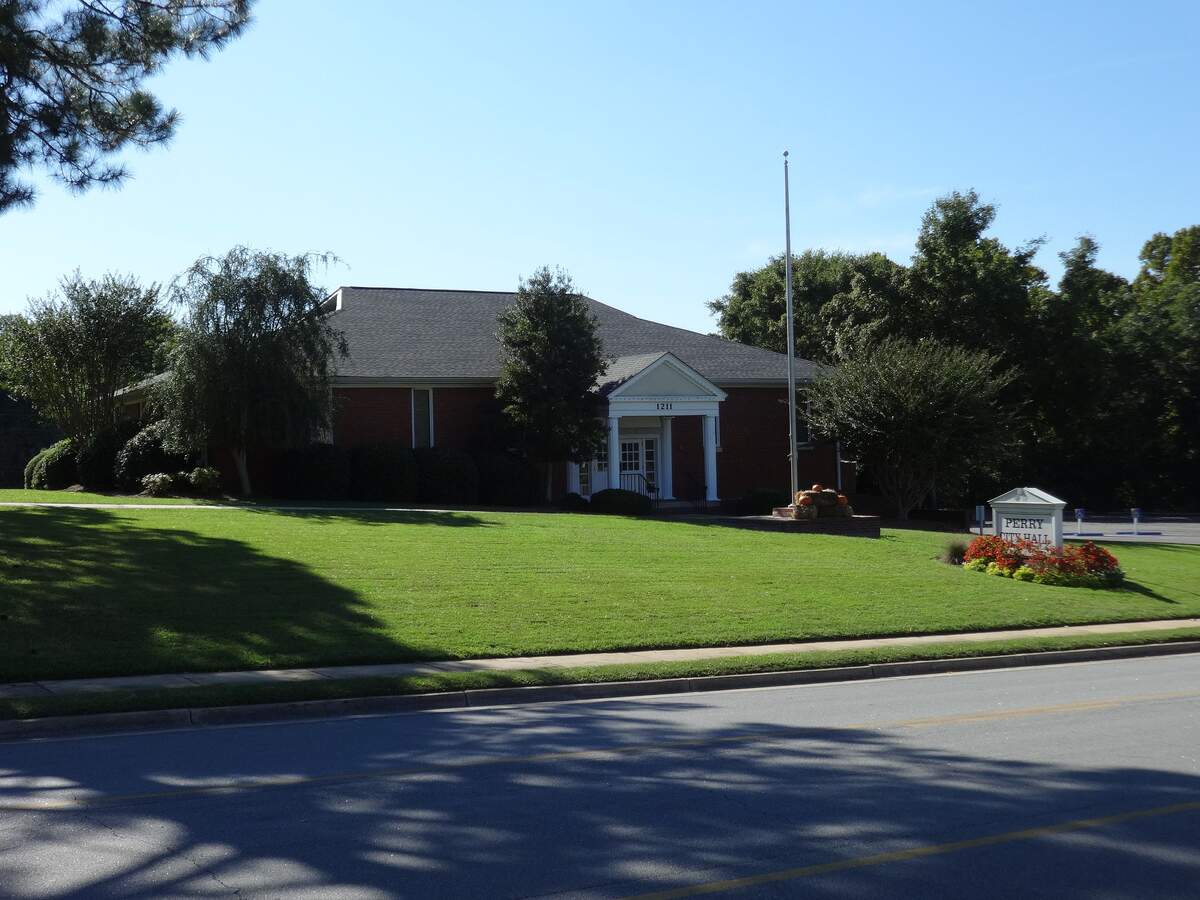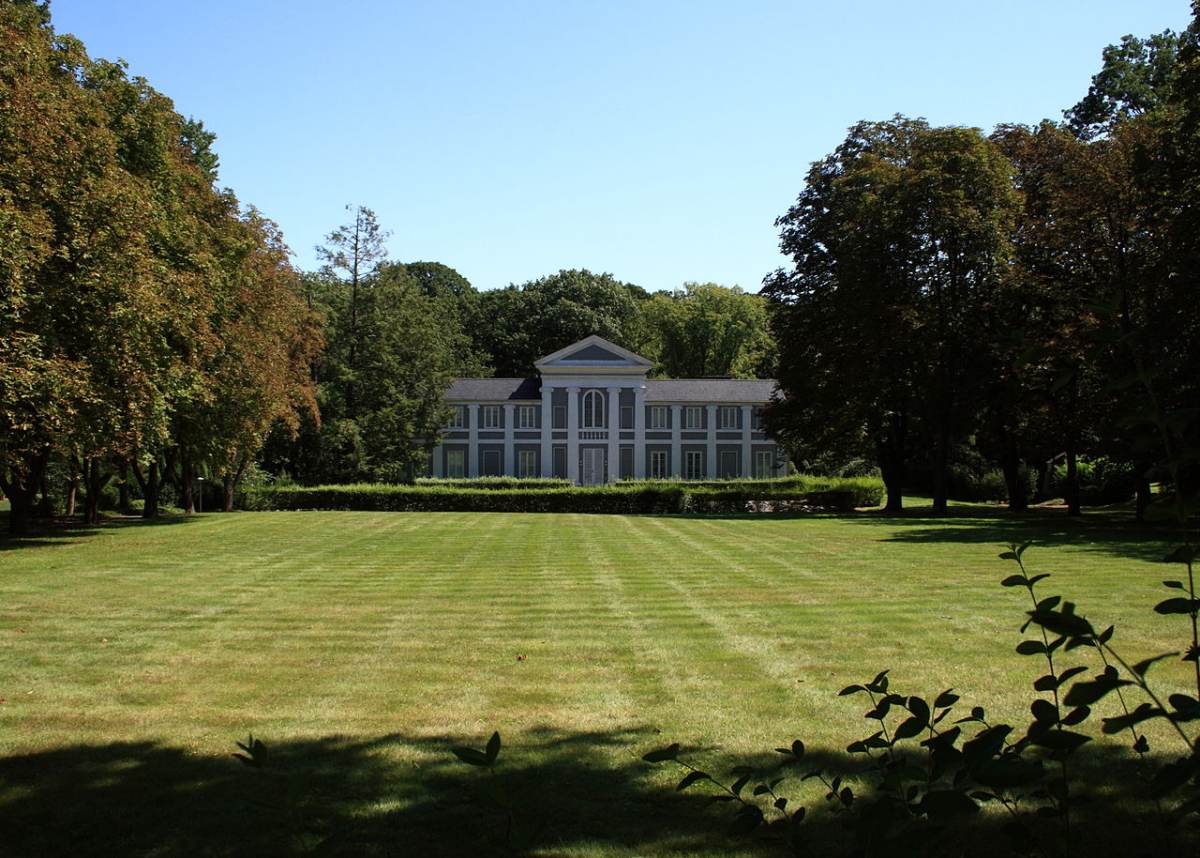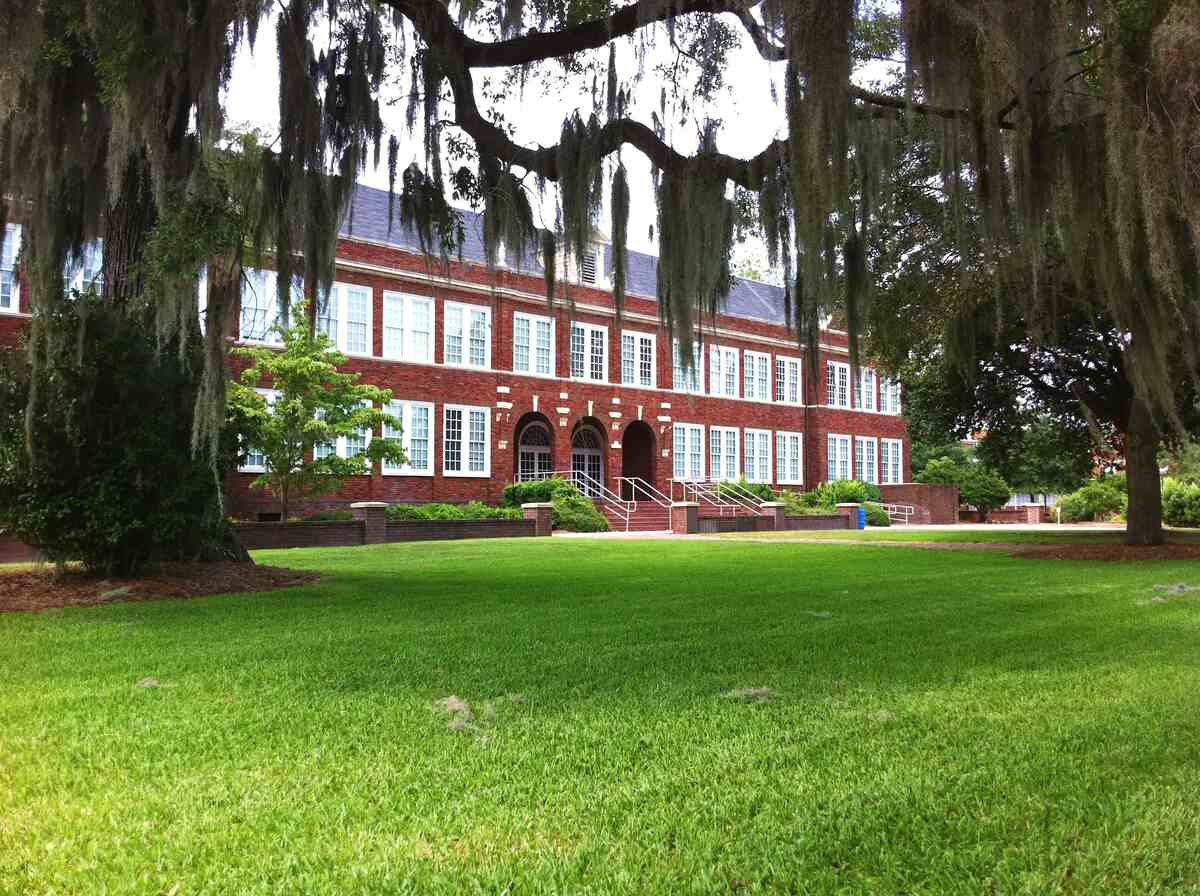
Known for its scenery, hospitality, and history, The Peach State has a peachy choice of grasses that will grow in its lawns. The grass types in Georgia include cool- and warm-season because Georgia’s climate ranges from the mountainous to the beach. This article discusses the best grass seed for Georgia.
Skip ahead to our guide on how to choose the best grass type for your Georgia lawn if you’re short on time.
Georgia Grasses on Your Mind
Georgia reaches from the Blue Ridge Mountains to the Gulf Coast and has been divided into five physiographical regions:
- Appalachian Plateau
- Ridge and Valley Region
- Blue Ridge Region
- Piedmont Region
- Coastal Plain
The first three, Appalachian, Ridge and Valley, and Blue Ridge, make up northern Georgia. The coastal plain, in south Georgia, has been divided into upper and lower regions. And then there’s the Piedmont region, which includes Atlanta, in the center.
Each area has a different grass requirement. In the mountainous northern region, you’ll typically want cool-season grasses, and the weather in the south calls for warm-season grasses. In the Piedmont region, warm-season grasses are preferred, but tall fescue also grows here.
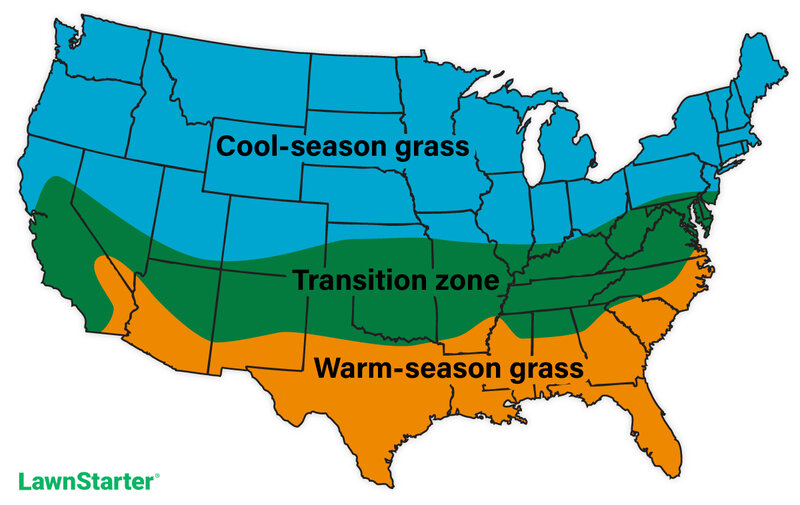
Cool-Season Grasses
Cool-season grasses grow in spring, early summer, and fall, when temperatures average 60 to 75 degrees F. If not watered, they become dormant during the hot and dryer summer months. If cool-season grasses are watered during summer, their growth rate slows but doesn’t stop, so thatet they can cope with the heat.
Turf-Type Tall Fescue

Aaron J. Patton, Ph.D. / Turfgrass Extension Specialist at Purdue University
Tall fescue is grown in Georgia’s mountainous and Piedmont regions and used for home lawns and soil stabilization. According to the University of Georgia, the southern boundary for seeding tall fescue grass is Griffin, south of Atlanta, but it can be found in shaded or protected microclimates south of the Piedmont.
Homeowners should plant turf-type tall fescue instead of Kentucky 31 or Alta, the older tall fescue grass varieties. The turf-type grasses are darker green, grow more slowly, and have a greater density and improved shade tolerance. They also have a deeper root system and can withstand drought conditions better than the old cultivars.
Classification: Cool-season grass
Spreads by: Produces short rhizomes but has a bunch-type growth habit
Shade tolerance: Moderate
Drought tolerance: Moderate to High
Foot traffic tolerance: Moderate
Maintenance needs: Frequent mowing. Does not produce significant thatch.
Mowing height: Set mowing height to 2 to 3 inches high; raise 0.5 inch higher in hot weather.
Potential for disease: Tolerant of most diseases when properly maintained.
Soil pH: 5.5-6.5
Soil type: Adapted to a wide range of soil conditions but prefers fertile clay soils with good drainage.
Other Notes: Tall fescue is a great option for a low-maintenance landscape.
Grass Seed Options:
– Triple-Play Tall Fescue Grass Seed Blend (5000 sq ft)
– Eretz Kentucky 31 K31 Tall Fescue Grass Seed (choose your size)
– Pennington The Rebels Tall Fescue Grass Seed Mix (7 lb.)
Kentucky Bluegrass

Photo Credit: Matt Lavin / Flickr / CC BY-SA 2.0
Kentucky bluegrass can perform well in the mountainous areas of north Georgia, but not as well as tall fescue. Plant a blend of two to three bluegrass cultivars or seed bluegrass with tall fescue. Kentucky bluegrass is one of the best grasses for high-traffic yards.
A Kentucky bluegrass lawn has a bright green color and can produce a high-quality, fine- to medium-textured turf. Kentucky bluegrass can become dormant during hot weather, but watering it keeps it from dormancy. It does best in Georgia lawns in partial shade but grows in the sunshine if it has moisture.
Classification: Cool-season grass
Spreads by: Rhizomes
Shade tolerance: Low
Drought tolerance: Moderate
Foot traffic tolerance: Moderate
Maintenance needs: Moderate mowing frequency and high fertilization needs.
Mowing height: Set mowing height between 3 and 4 inches.
Potential for disease: Moderate to high; prone to several diseases, such as dollar spot, leaf spot, necrotic ring spot, summer patch, and stripe smut.
Soil pH: 5.5–6.5
Soil type: Performs best in well-drained, heavy soils with high fertility.
Grass Seed Options:
– Jonathan Green (11970) Blue Panther Kentucky Bluegrass Grass Seed (3 lbs.)
– SeedRanch Midnight Kentucky Bluegrass Seed (5 lbs.)
Perennial Ryegrass
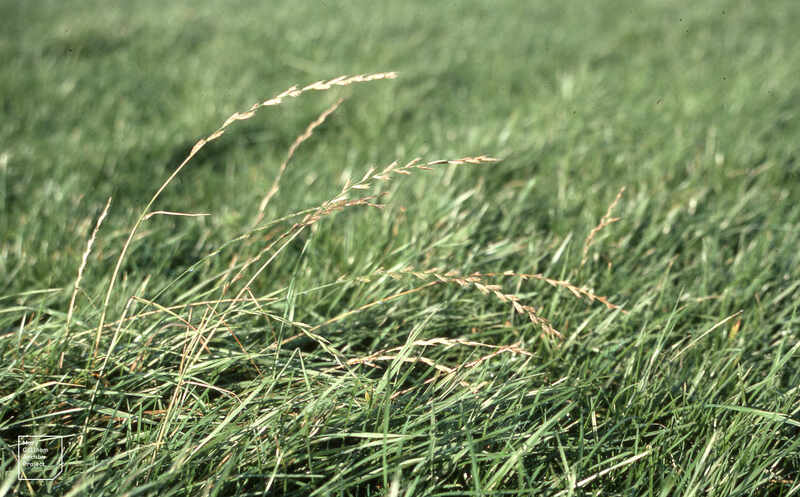
Photo Credit: Dr Mary Gillham Archive Project / Flickr / CC BY 2.0
Homeowners in Georgia treat perennial ryegrass as an annual; they overseed it into Zoysiagrass or Bermudagrass during fall lawn care to provide a green lawn through the winter and spring. As the warm-season turf greens up again in spring, the perennial ryegrass then dies by early summer when temperatures become too hot.
Many cultivars exist; most have a dark green color, a consistent growth rate, and tolerance to heavy foot traffic. Don’t confuse perennial ryegrass with annual ryegrass, though. Annual ryegrass is coarser than perennial ryegrass, is a lighter green, and tolerates less wear and tear.
Classification: Cool-season grass
Spreads by: Has a bunch-type growth habit
Shade tolerance: Low
Drought tolerance: Low
Foot traffic tolerance: High
Maintenance needs: Moderate mowing and fertilization requirements. Thatch is not significant.
Mowing height: Set mowing height to 1 to 3 inches
Potential for disease: High. Common diseases include gray leaf spot, red thread, and leaf spot/melting-out.
Soil pH: 5.5–6.5
Soil type: Prefers good drainage and fertility but can tolerate some poor drainage.
Grass Seed Options:
– Outsidepride Perennial Ryegrass Seed (5 lbs.)
– Eretz ProTurf Perennial Ryegrass Fine Lawn Seed (choose your size)
Fine Fescues
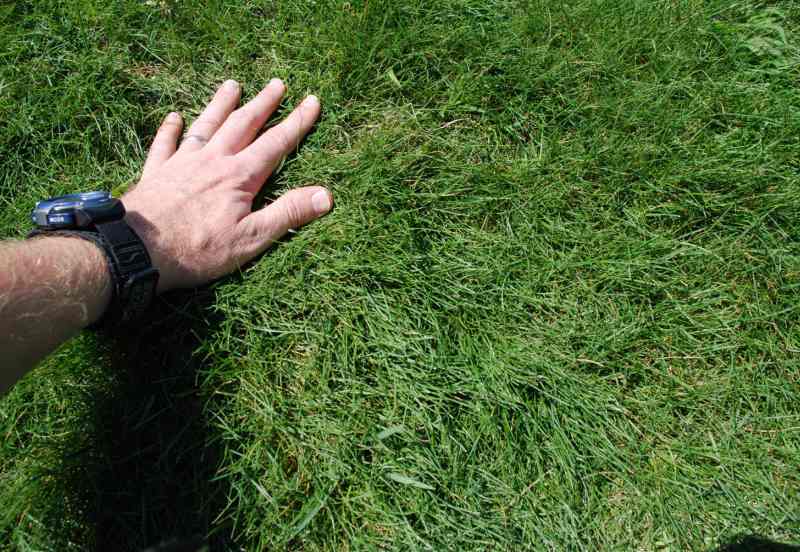
Aaron J. Patton, Ph.D. / Turfgrass Extension Specialist at Purdue University
Several species of grasses make up the fine fescues that some occasionally confuse with tall fescue. Tall fescue tolerates the Georgia climate better than fine fescues, but the fine fescues are used in grass seed mixtures to help lawn performance in shady areas. Homeowners can also use fine fescue to overseed lawns in the fall.
Classification: Cool-season grass
Spreads by: Creeping red fescue spreads by rhizomes, whereas other fine fescues are bunch-type grasses, such as Chewings, hard, and sheep fescues.
Shade tolerance: Moderate to high, depending on species
Drought tolerance: Moderate to high, depending on species
Foot traffic tolerance: Low to moderate, depending on species
Maintenance needs: Low fertilizer and mowing needs
Mowing height: Set mowing height between 3 and 4 inches, depending on species.
Potential for disease: Moderate. Common diseases include red thread, leaf spot, dollar spot, summer patch, and powdery mildew.
Soil pH: 5.5-6.5
Soil type: Will not perform well in wet soil conditions. Prefers drier soils and tolerates a wide range of soil types and fertility.
Other notes: Fine fescues are adapted to Georgia’s mountain regions. They work well as the shade element in cool-season sun-shade mixes.
Grass Seed Options:
– Outsidepride Legacy Fine Fescue Grass Seed (5 lbs.)
– Eretz Creeping Red Fine Fescue Seed (choose your size)
– Outsidepride Creeping Red Fine Fescue Grass Seed (25 lbs.)
– Outsidepride Hard Fine Fescue Grass Seed (10 lbs.)
Warm-Season Grasses
Warm-season grasses begin to grow in May and keep growing until mid-September. They are heat-tolerant grasses that flourish in high temperatures and reduced rainfall. Warm-season grasses become dry and dormant in the winter.
Bermudagrass
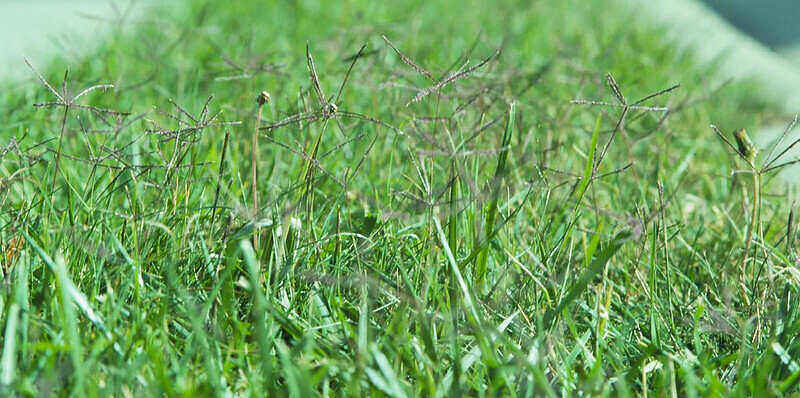
Photo Credit: Matt Levin / Flickr / CC BY-SA 2.0
Bermudagrass thrives in hot weather but not in the shade in lawns in Georgia. It grows rapidly in any soil type unless the soil has poor drainage. Bermudagrass makes a good turfgrass statewide. It has become well adapted to sandy soils and recovers rapidly from injury, an ideal trait for lawns that host summer BBQs and weekend sports.
Bermudagrass cultivars with high cold tolerance may grow well in the transition zone, or the northern third of the state. Cultivars also have different textures, from coarse to fine. This type of grass typically forms a dense turf due to its aggressive growth. However, it can be difficult to keep Bermudagrass out of flower beds and off of walks and borders.
Classification: Warm-season grass
Spreads by: Stolons and rhizomes
Shade tolerance: Low; thrives in full sun
Drought tolerance: High
Foot traffic tolerance: High
Maintenance needs: Needs frequent mowing due to fast growth rate; develops thatch easily; needs regular fertilization.
Mowing height: Set the mowing height between 1 and 2 inches for hybrid and common Bermudagrass; raise 0.5 inch higher in hot weather.
Potential for disease: Good resistance to disease, although diseases are common; low resistance to insects
Soil pH: 5.5–6.5
Soil type: Tolerates most soil types
Grass Seed Options:
– Scotts Turf Builder Bermudagrass (10-lb. bag)
– Hancock Seed Co. Bermudagrass (50-lb. bag)
Centipedegrass
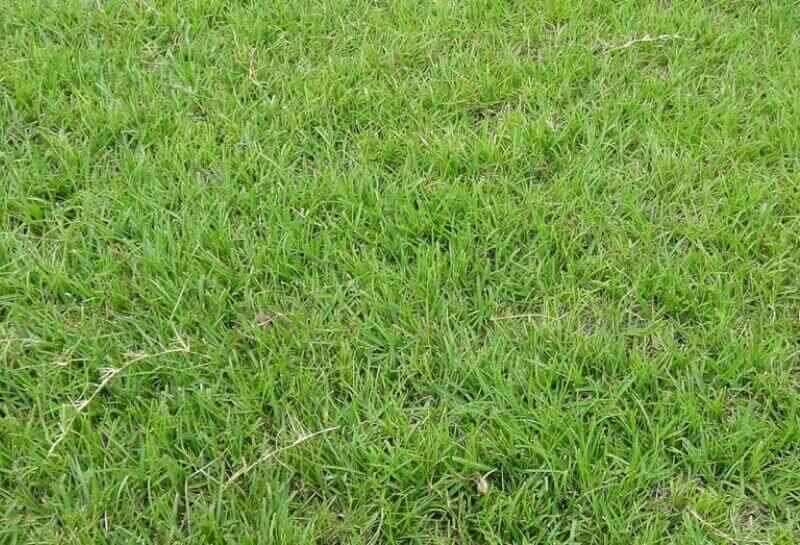
Photo credit: Michael Rivera / Wikimedia Commons / CC BY-SA 4.0
Centipedegrass, one of the 5 best grass types for Atlanta’s Piedmont region and the lower parts of the state, can be grown statewide. It grows slowly in summer and turns brown and dormant in winter. Its color is a fun Granny Smith apple green.
The TifBlair cultivar is more cold tolerant than common centipedegrass and retains its color in lawns later in the year. One cultivar can be seeded into the other without affecting the lawn visually.
Classification: Warm-season grass
Spreads by: Stolons
Shade tolerance: Moderate
Drought tolerance: Moderate
Foot traffic tolerance: Low
Maintenance needs: Low fertilization. Mowing every 5 to 7 days. Can become thatchy.
Mowing height: Set the mowing height between 1 and 2 inches; raise 0.5 inch higher in hot weather.
Potential for disease: Good resistance to diseases and insects. Susceptible to large patch during the spring.
Soil pH: 5-6
Soil type: Acidic, infertile, at least moderately good drainage (very dense, clay soils produce poor results)
Other notes: Centipedegrass decline occurs when the grass doesn’t turn green in the spring and ultimately dies. This problem can be prevented by proper centipede lawn maintenance.
Grass Seed Options:
– Gulf Kist Coated Centipedegrass Seeds (1 lb.)
– Scotts EZ Seed Patch and Repair Centipedegrass (3.75 lbs.)
– TifBlair Centipedegrass (5-lb. bag)
St. Augustinegrass
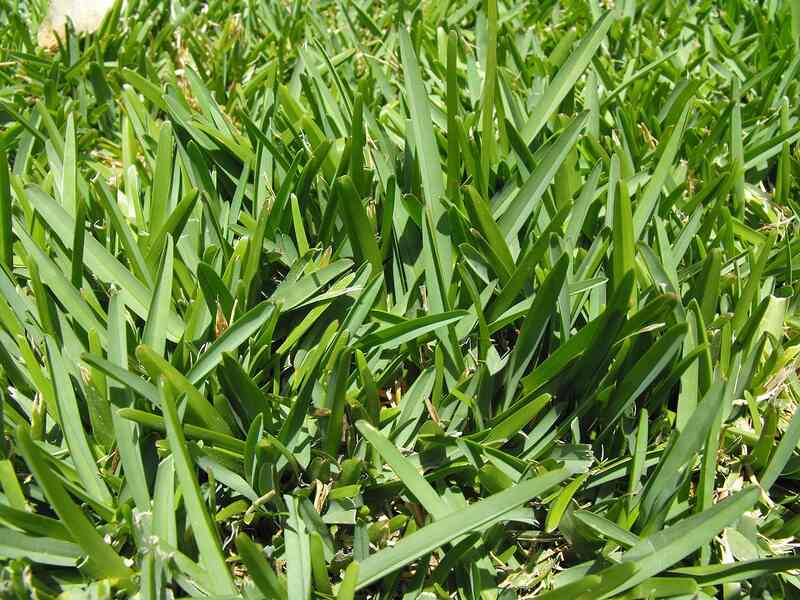
St. Augustinegrass is not grown with seeds; in new lawns, it can be sodded or established using sprigs or plugs. Best adapted to the middle and lower part of Georgia, it also grows in many lawns in the Atlanta area.
St. Augustinegrass tolerates shade and salt but not cold. Its color ranges from medium to dark green. It can produce dense, lush lawn grass and chokes out most weeds, but it does have a few common lawn pests, including:
- Chinch bugs
- White grubs
- Mole crickets
Applying fertilizer once a year usually produces a healthy lawn.
Classification: Warm-season grass
Spreads by: Stolons
Shade tolerance: Moderate. It is the most shade tolerant warm-season grass.
Drought tolerance: Moderate to High
Foot traffic tolerance: Low
Maintenance needs: Needs frequent mowing due to fast growth rate; develops thatch easily; needs regular fertilization.
Mowing height: Set the mowing height between 2 and 3 inches; raise 0.5 inch higher in hot weather.
Potential for disease: Moderate to high; susceptible to gray leaf-spot, pythium root rot, and take-all root rot.
Soil pH: 5.5–6.5
Soil type: Tolerates many soil types; prefers moderately fertile and moist (not waterlogged) soils; doesn’t tolerate soil compaction.
Grass Plug Options:
– Seed Ranch St Augustine Seville Grass Plugs (2 Trays)
– Seed Ranch St Augustine Floratam Grass Plugs (2 Trays)
Zoysiagrass
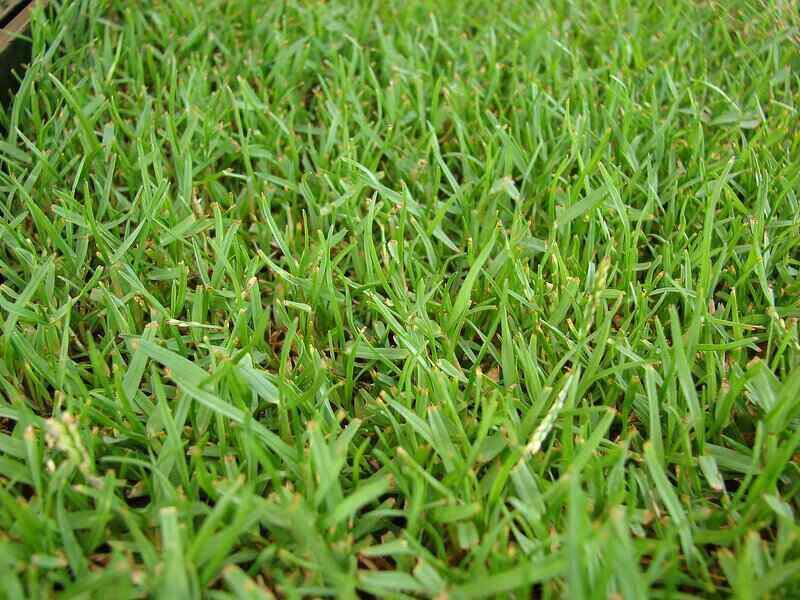
Photo Credit: Forest & Kim Starr / Wikimedia Commons / CC BY 3.0 US
Zoysiagrass makes a pretty golf course and an attractive lawn, even in winter, when it’s dormant. Zoysiagrass lawns tolerate cold well despite it being a warm-season grass; it also tolerates salt. This low-maintenance grass has adapted to the entire state and has increased in popularity and use. It is one of the easiest grasses to grow in Georgia.
Most Zoysiagrasses must be planted with sod, plugs, or sprigs, but pay attention to when you plant; planting during the winter results in more injury to the grass.
Classification: Warm-season grass
Spreads by: Stolons and rhizomes
Shade tolerance: Moderate
Drought tolerance: Moderate to High
Foot traffic tolerance: High, but recovers slowly from damage
Maintenance needs: Low nitrogen fertilization requirements, although it’s prone to thatch build-up. Once established, doesn’t need much mowing.
Mowing height: Set mowing height between 1 and 2 inches; raise 0.5 inch higher in hot weather.
Potential for disease: Good disease tolerance overall but can get brown patch, rust, and dollar spot diseases
Soil pH: 6-7
Soil type: Well-draining, some cultivars are more tolerant of a wide range of soils than others.
Other notes: Two commercially available cultivars, Zenith and Compadre, can be seeded or sodded. However, the best quality Zoysia lawns come from sod since Zoysia is a slow grower.
Grass Plug and Seed Options:
– Zoysia Plugs (50 Large Grass Plugs)
– Zoysia Plugs (50 Full & Lush Grass Plugs)
– Zoysia Plugs (100 Plugs)
– Zenith Zoysia Grass Seeds (1/8 lb. of seeds)
Best Grass Seed for North Georgia
North Georgia comprises the Appalachian, Ridge and Valley, and Blue Ridge regions. The north of the Peach State is also in the transition zone, where homeowners usually opt for a cool-season grass but can also plant a warm-season cultivar resistant to colder temperatures.
The best grass for north Georgia is turf-type tall fescue, but Kentucky bluegrass, perennial ryegrass, fine fescue cultivars, Bermuda, and Zoysia also perform well here.
Best Grass Seed for Central Georgia
The University of Georgia Cooperative Extension has declared Zoysiagrass lawns as one of the best for the Piedmont, or central, region of Georgia. The other warm-season grasses (Bermudagrass, centipedegrass, and St. Augustinegrass) also do well in this part of the state, which includes lawns in Atlanta. Perennial ryegrass can be used for winter overseeding.
Best Grass Seed for South Georgia
The Coastal Plains region warrants warm-season grasses such as centipedegrass and St. Augustinegrass. Bermudagrass and Zoysiagrass also grow well here. These grasses provide good low-maintenance landscaping and are well suited to the heat of the southern Georgia plains.
How to Choose the Best Grass Type for Your Georgia Lawn
The first thing you want to consider when selecting a grass is where you live. If you live in northern Georgia, you’ll likely be choosing a cool-season grass. If you live in the coastal plains, you’ll probably want a warm-season grass. In the Piedmont region, you can go either way.
But there are a few other things you’ll need to consider. Here they are.
Shade Tolerance
Maybe you’re taking the midnight train through Georgia, but your grass isn’t. It needs more than moonlight; it needs sunlight but perhaps a bit of shade.
High shade tolerance: Fine fescue
Moderate shade tolerance: Turf-type tall fescue, centipedegrass, St. Augustinegrass, Zoysiagrass
Low shade tolerance: Kentucky bluegrass, perennial ryegrass, Bermudagrass
Heavy Foot Traffic
Your kids or your pets like to run around outside and play. Or maybe you’re the one who likes to play outside. Either way, you’ll want a grass with a fairly high tolerance for foot traffic. If your yard’s job is to sit there and look pretty, feel free to choose any of these grasses.
High foot traffic: Perennial ryegrass, Bermudagrass, Zoysiagrass
Moderate foot traffic: Turf-type tall fescue, Kentucky bluegrass
Low foot traffic: Centipedegrass, St. Augustinegrass, fine fescue
High vs. Low Maintenance
When the devil went down to Georgia, he was looking for some fun. He certainly wasn’t looking to spend a lot of time on his grass. But if you don’t want to spend time on your grass, it will show in its quality. The higher the maintenance, the better the quality.
High-maintenance grasses: Bermudagrass, St. Augustinegrass, Kentucky bluegrass,
Moderate-maintenance grasses: Turf-type tall fescue, perennial ryegrass, Zoysiagrass
Low-maintenance grasses: Centipedegrass, fine fescue
Drought Tolerance
There have been some major droughts in Georgia in the past. There probably will be again. As a result, you may want to choose a grass with a high to moderate tolerance to drought.
High drought tolerance: Bermudagrass, centipedegrass, fine fescue
Moderate drought tolerance: St. Augustinegrass, Zoysiagrass, Kentucky bluegrass, turf-type tall fescue
Low drought tolerance: Perennial ryegrass
Call a Pro
Selecting the right grass is key for establishing attractive and problem-free lawns in Georgia. You should make your decision “based on environmental conditions, turf quality, desired appearance, and maintenance requirements.” Temperature, moisture, shade adaptation, soil pH, and fertility are important, too.
If all this seems confusing and just too much to consider, you can look for a Georgia lawn care pro near you. We have trusted lawn care pros in Atlanta, Augusta, Marietta, Roswell, Savannah, and many more cities across the Peach State.
Additional source:
Lawns in Georgia: Selection and Species
Main Image Credit: Renégat / Flickr / CC BY-SA 2.0
LawnStarter participates in the Amazon Services LLC Associates Program, an affiliate advertising program. LawnStarter may earn revenue from products promoted in this article.

